

Namespaces and DTDs.
Dtd. Communities. Schemas. XML in 10 points. | Translations XML, XLink, Namespace, DTD, Schema, CSS, XHTML ...
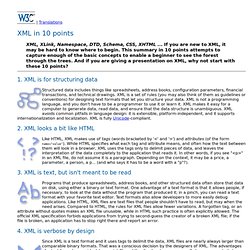
If you are new to XML, it may be hard to know where to begin. This summary in 10 points attempts to capture enough of the basic concepts to enable a beginner to see the forest through the trees. And if you are giving a presentation on XML, why not start with these 10 points? 1. Structured data includes things like spreadsheets, address books, configuration parameters, financial transactions, and technical drawings. 2.
Like HTML, XML makes use of tags (words bracketed by '<' and '>') and attributes (of the form name="value"). 3. Programs that produce spreadsheets, address books, and other structured data often store that data on disk, using either a binary or text format. 4. Since XML is a text format and it uses tags to delimit the data, XML files are nearly always larger than comparable binary formats. 5. Is the specification that defines what "tags" and "attributes" are. XLink XPointer. XML basics for new users. XML stands for Extensible Markup Language, with the markup bit being the key.

You can create content and mark it up with delimiting tags, making each word, phrase, or chunk into identifiable, sortable information. The files, or document instances, you create consist of elements (tags) and content, and the elements help the documents to be understood fairly well when read from printouts or even processed electronically. The more descriptive the elements, the more a document's parts can be identified.
From the early days of markup to today, one advantage of tagging content is that if a computer system is lost, the data in print can still be understood from its tags. Markup languages evolved from early, private company and government forms into Standard Generalized Markup Language (SGML), Hypertext Markup Language (HTML), and eventually into XML. DeveloperWorks : New to XML. Although the tags you see in Listing 1 are the most common serialization of XML, it is very common to deal with XML data in the context of an application.
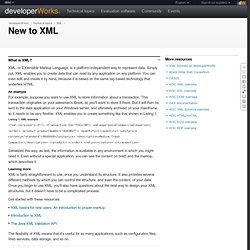
In that case, you will typically use one of several models, including the following. The Document Object Model (DOM) XML and Databases. Copyright 1999-2005 by Ronald Bourret Last updated September, 2005 This article also available in: Table of Contents 1.0 Introduction This paper gives a high-level overview of how to use XML with databases.
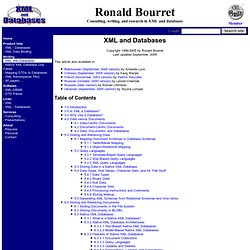
XML- The Benefits. Who uses XML? Drafting Legislation Using XML at the U.S. House of Representatives. Drafting Legislation at the U.S.
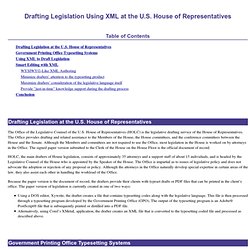
House of RepresentativesGovernment Printing Office Typesetting SystemsUsing XML to Draft LegislationSmart Editing with XML WYSIWYG-Like XML Authoring Minimize drafters’ attention to the typesetting product Maximize drafters’ consideration of the legislative language itself Provide “just-in-time” knowledge support during the drafting processConclusion Drafting Legislation at the U.S. Using an XML file with Flash. (Click image to open XML-based Flash movie in sized window) What is XML and how is it used with Flash? XML (EXtensible Markup Language) is a way of structuring information in a text-based file using tags that are similar to HTML tags, but not predefined as HTML tags are. Instead, you make up the tags (or use one of the evolving XML application standards) which best define your data structure, or use the XML file generated by conversion from spreadsheet or database content.
Providing your XML file follows the correct structure (one root tag enclosing all others, tags nested within others, and all tags properly closed), Flash can read the file and convert it to an instance of the XML class. As of Flash MX 2004, Flash does not use DTDs (Document Type Definition files), which are used by some other XML-reading applications. Like the other types of operations involving accessing files on a web server, XML access is an asynchronous operation. NLM uses XML for MEDLINE Data. When the National Library of Medicine endeavored to modernize its computer systems in the late 1990s/early 2000s, the NLM chose XML (eXtensible Markup Language) as the new tagged format for disseminating its MEDLINE bibliographic citation data.

A DTD (Document Type Definition) defines the structure of this XML. This is the only distribution format for MEDLINE data created beginning with the 2001 production year. The suite of DTDs used for MEDLINE/PubMed data are available at This decision strengthens NLM's commitment to distribute its journal citation data in a format that is widely described and, therefore, familiar to many in the information industry, especially in the Internet Web environment. XML lends itself to human readability as well as to easy machine manipulation. Css xml attributes - RE: CSS and XML attributes. Introduction to CSS 2.1. 2.1 A brief CSS 2.1 tutorial for HTML This section is non-normative.
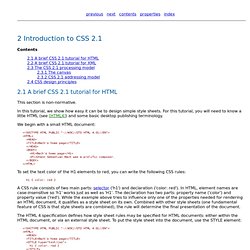
In this tutorial, we show how easy it can be to design simple style sheets. For this tutorial, you will need to know a little HTML (see [HTML4]) and some basic desktop publishing terminology. We begin with a small HTML document: <! To set the text color of the H1 elements to red, you can write the following CSS rules: A CSS rule consists of two main parts: selector ('h1') and declaration ('color: red'). The HTML 4 specification defines how style sheet rules may be specified for HTML documents: either within the HTML document, or via an external style sheet. What Place Has CSS in the XML World? March 08, 2000 Is CSS a good style language to use with XML?
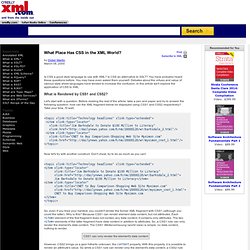
Is CSS an alternative to XSLT? You have probably heard these questions before. You may have even asked them yourself. Debates about the virtues and value of various style sheet languages have tended to increase the confusion. What is Rendered by CSS1 and CSS2? Let's start with a question. Now let's try with another construct. Hands-on XSL. XSL is a style sheet language for documents marked up using XML, the Extensible Markup Language, which can be thought of as "SGML for the Web.

" XSLT is used to describe how an XML source document is transformed into another XML document that uses the XSL formatting vocabulary. However, XSLT may be used for other general transforms as well. This exercise will deal with one of the most practical tasks for XSLT, transforming an XML document into an HTML document that can be viewed by any Web browser. For your information, this exercise demonstrates section 5.1 of the "XSLT Recommendation, Processing Model" (see Resources). Don't expect to understand this paragraph right now, but come back after completing the exercise to see if this quote from the spec makes more sense. "A list of source nodes is processed to create a result tree fragment.
The key features of XSLT are: Convert XML to Tree structure GUI chart (XML and Related Technologies forum at JavaRanch) Index of /xml. Mulberry Technologies, Inc. Help getting to a parent node in JavaScript.